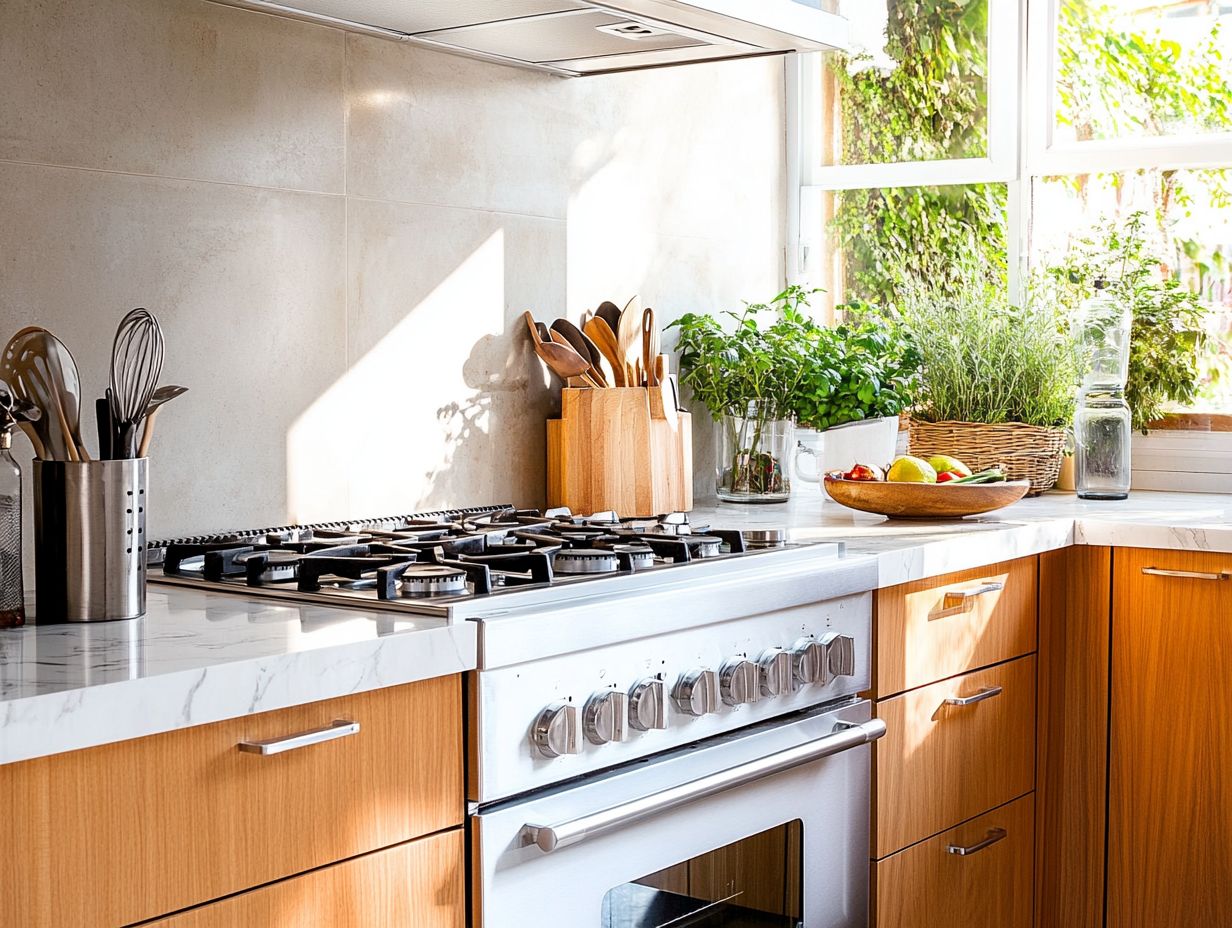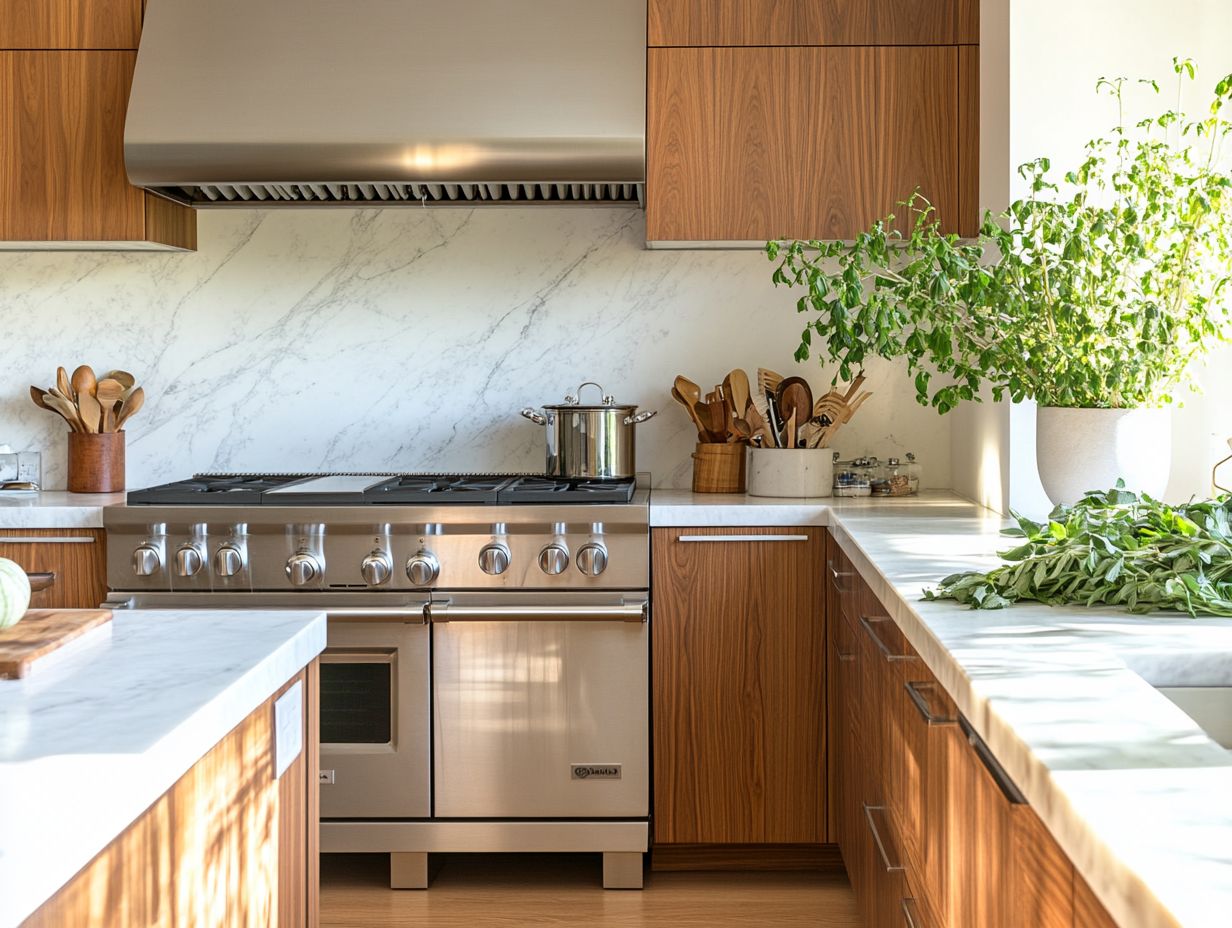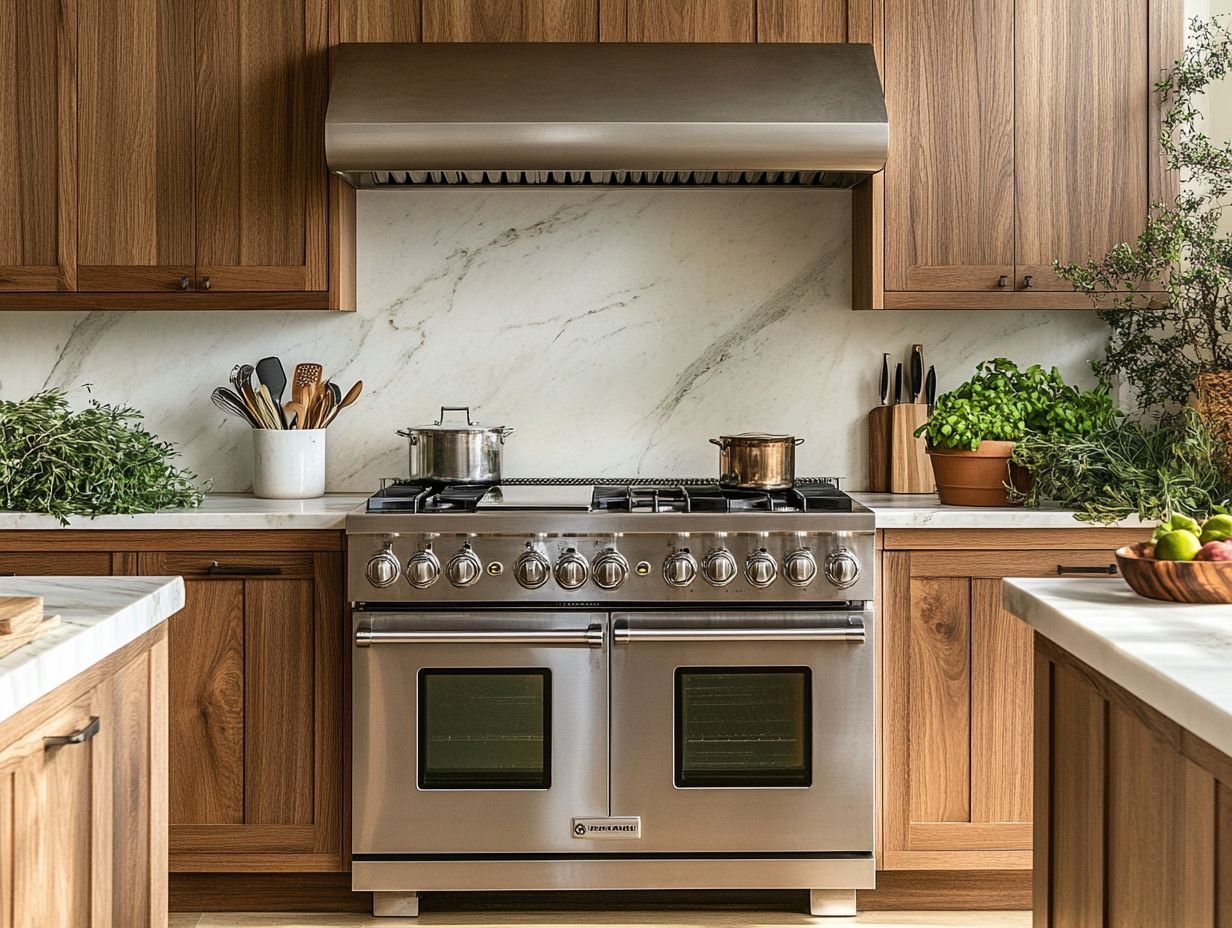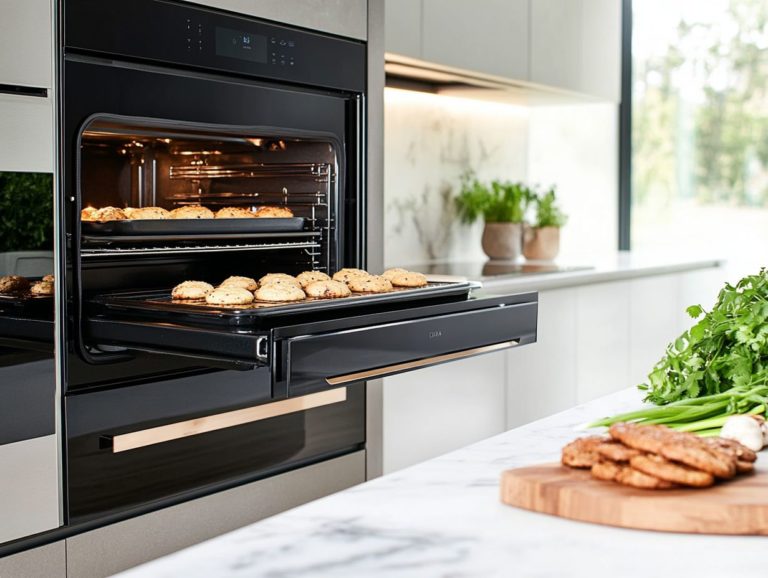How to Pick a Kitchen Range That Fits Your Style
Choosing the right kitchen range can transform your cooking experience and enhance your kitchen’s overall design. With many options available—ranging from gas and electric to sleek induction models—navigating these choices can feel daunting.
This guide will help you understand your kitchen space, evaluate your layout, and explore the various types of ranges on the market. It will also cover essential factors such as your cooking habits, budget considerations, and must-have features, ensuring you find the perfect range that aligns with your style and needs.
Contents
- Key Takeaways:
- Understanding Your Kitchen Space
- Types of Kitchen Ranges
- Factors to Consider When Choosing a Kitchen Range
- Additional Features to Look for
- Frequently Asked Questions
- What factors should I consider when picking a kitchen range that fits my style?
- What are the different types of kitchen ranges available?
- How do I determine the right size for my kitchen range?
- What style of kitchen range is best for a small kitchen?
- Is it important to match my kitchen range with other appliances?
- How can I add my personal style to my kitchen range?
Key Takeaways:

- Assess your kitchen space and layout to determine the right size and type of range.
- Consider your cooking needs, budget, and aesthetic preferences when choosing between gas, electric, or induction ranges.
- Look for additional features like convection cooking, self-cleaning options, and smart technology integration to enhance your cooking experience.
Understanding Your Kitchen Space
Understanding your kitchen space is the crucial first step in selecting the perfect kitchen range that fits your culinary needs and personal style.
The layout of your kitchen—whether it’s open or closed—plays a significant role in guiding your choice among various range styles, including gas, electric, or induction options.
Taking accurate measurements is crucial for ensuring the range integrates seamlessly into your cabinetry. Don’t overlook essential factors like kitchen ventilation and appliance features; these elements are vital for creating a functional and aesthetically pleasing kitchen design that truly reflects your vision.
Assessing Your Kitchen Layout and Measurements
Assess your kitchen layout and measurements. This helps ensure your new range fits well and boosts your cooking experience.
Understanding countertop heights and layout provides valuable insights into how to arrange your appliances for optimal access and workflow. When considering kitchen design, it’s crucial to think about how these adjustments can enhance accessibility and foster a more efficient cooking environment.
By thoroughly evaluating both the measurements and arrangement of your kitchen, you can confidently select the perfect kitchen range, microwave, or refrigerator, ensuring that every piece harmonizes with the overall layout.
Types of Kitchen Ranges
The types of kitchen ranges available are diverse, encompassing options such as gas, electric, induction, and dual-fuel ranges. Each caters to different cooking styles and personal preferences.
If you value precise temperature control, a gas range may be your ideal choice. An electric range is often celebrated for its sleek design and energy efficiency.
Induction ranges are gaining popularity for their smart cooking features and rapid heating capabilities, making them a perfect fit for contemporary kitchens.
By understanding these various range styles, you can confidently make a choice that aligns with your cooking habits and the overall look of your kitchen.
Gas vs. Electric vs. Induction
When deciding between gas, electric, and induction ranges, grasping the strengths and weaknesses of each can profoundly influence your cooking experience.
Gas ranges are often the top choice for those who relish immediate heat and precise temperature control, making them perfect for culinary enthusiasts who thrive on hands-on cooking.
Electric ranges provide consistent heating and are typically easier to clean, although they may take longer to reach your desired temperature.
Induction ranges shine in energy efficiency, heating pots and pans quickly while remaining cool to the touch—a feature many consumers value for safety.
Customer feedback often highlights the sleek design and responsive features of induction models, while traditional gas users rave about their level of control over the flames.
Each type has unique attributes that cater to various preferences, making your decision largely dependent on your cooking habits and the dynamics of your kitchen.
Now that you’re informed, start exploring your options and find the kitchen range that’s perfect for you!
Freestanding vs. Slide-In vs. Built-In

Choosing between freestanding, slide-in, and built-in ranges requires a thoughtful understanding of how each option influences your kitchen design and functionality.
Each style brings its own design implications, significantly shaping the overall aesthetic of your kitchen.
Freestanding ranges offer versatility and ease of installation. This allows you to change your layout with minimal hassle.
In contrast, slide-in options provide a built-in look, harmonizing beautifully with various cabinetry styles. This creates a seamless transition between the appliance and the kitchen design.
Built-in ranges often require more upfront planning and precise cabinetry alignment. However, they maximize space efficiency and deliver a custom finish that caters to specific layout preferences.
Thus, selecting the right range is crucial for enhancing both the practical aspects and visual harmony of your kitchen design.
Factors to Consider When Choosing a Kitchen Range
When selecting a kitchen range, consider key factors: your cooking needs, habits, budget, and preferences for energy efficiency.
Knowing your specific cooking style—whether you enjoy baking, sautéing, or grilling—will guide you in choosing a range that truly supports your culinary aspirations.
Also, consider the installation options and the availability of services. This ensures your new appliance integrates seamlessly into your kitchen layout while fitting comfortably within your budget.
Cooking Needs and Habits
Understanding your cooking needs and habits can enhance your culinary style and preferences.
For instance, if you often use high-heat techniques like stir-frying or searing, powerful gas burners may be ideal for swift temperature adjustments.
Conversely, if you enjoy slow-cooking or simmering delicate sauces, an electric stove with precise heat control might be your perfect match.
If baking ignites your passion, you’ll want features that ensure even baking, like a fan that circulates hot air.
Ultimately, recognizing the diverse influences of cooking styles empowers you to make an informed decision, ensuring your chosen range complements your kitchen aesthetic and elevates your culinary pursuits.
Budget and Energy Efficiency
Budget and energy efficiency are vital when choosing a kitchen range, as they significantly influence your initial investment and ongoing utility expenses.
While a high-efficiency model might seem like a stretch at first, the long-term savings on energy bills can balance out that upfront cost.
By exploring different types of ranges, you can discover variations in initial pricing and how each model’s efficiency contributes to a more sustainable kitchen environment.
Efficient burners use less energy while still delivering stellar cooking performance. This makes them a smart choice for anyone looking to manage their budget wisely.
By grasping the complete cost of ownership, you empower yourself to make a decision that aligns with your financial objectives and commitment to the environment.
Design and Aesthetic Preferences
Design and aesthetic preferences play a pivotal role when selecting a kitchen range that integrates seamlessly with your kitchen’s overall look and feel.
The right choice of color, finish, and style enhances not just functionality but also visual allure.
For example, a sleek stainless steel range can complement a modern, minimalist design, while a vintage-inspired option in vibrant hues brings warmth and charm to a rustic setting.
The finishes—whether matte, glossy, or textured—add depth and character to the space, significantly influencing how cabinetry and countertops interact.
By thoughtfully considering these elements, you can create a cohesive aesthetic that transforms your kitchen into a welcoming hub, showcasing your personal style and elevating the overall ambiance.
Additional Features to Look for

When selecting a kitchen range, consider additional features like convection cooking, self-cleaning options, and smart technology.
These enhancements can significantly elevate your cooking experience and improve efficiency in the kitchen.
Don’t miss the chance to find the perfect range that will transform your kitchen!
Convection Cooking
Ready to unlock the secret to perfectly cooked meals? The convection feature in your kitchen range can elevate your cooking performance by distributing heat evenly throughout the oven.
This method uses a fan and an exhaust system to circulate heated air, ensuring that every dish receives consistent warmth from all angles. Your foods cook more quickly and evenly, making convection the ideal choice for baking pastries, roasting meats, and even dehydrating fruits and vegetables.
The true advantage of this cooking style lies in its ability to reduce cooking times while enhancing flavor and texture—a game changer for both busy home cooks and gourmet chefs alike.
By incorporating convection into your culinary toolkit, you open up new possibilities and truly elevate your meals.
Self-Cleaning Options
Looking for an easier way to keep your kitchen clean? Self-cleaning options in kitchen ranges offer you a sophisticated solution for maintaining cleanliness without the tediousness of manual scrubbing.
These innovative mechanisms take various forms, such as steam cleaning, which harnesses the power of steam to loosen grime, and high-heat pyrolytic cleaning (this method uses extreme heat to burn away food residues), where temperatures escalate to incinerate residues.
Another effective method features catalytic liners that absorb spills and break them down during cooking. Each approach presents unique benefits, allowing you to relish your culinary experiences without the anxiety of post-cooking cleanup.
By incorporating these advanced features, you not only save valuable time but also ensure your appliances remain in peak condition, ultimately enhancing the efficiency and enjoyment of your meal preparation.
Smart Technology Integration
Want to simplify your cooking experience? Smart technology integration in kitchen ranges provides you with innovative cooking solutions that enhance convenience and efficiency in your culinary endeavors.
With features like remote control, you can effortlessly adjust settings from anywhere in your home, ensuring perfect results without being confined to the kitchen. Advanced temperature management enables precise cooking, reducing the risk of overcooking or undercooking your dishes.
These smart cooking functions streamline meal preparation and offer valuable insights through real-time notifications, gently reminding you when it’s time to check on your meals.
This seamless blend of technology not only transforms your cooking but also invites you to explore delicious new recipes with confidence!
Frequently Asked Questions
What factors should I consider when picking a kitchen range that fits my style?

When choosing a kitchen range, consider your cooking needs, kitchen space, budget, and preferred cooking style. These factors will help you narrow down your options and find the perfect range for your style.
What are the different types of kitchen ranges available?
There are three main types of kitchen ranges: gas, electric, and dual fuel. Gas ranges are known for their precise temperature control, electric ranges are more budget-friendly, and dual fuel ranges combine the best of both worlds.
How do I determine the right size for my kitchen range?
To determine the right size for your kitchen range, measure the width, depth, and height of the space where the range will be installed. Ensure to leave at least three inches of clearance on each side for ventilation.
What style of kitchen range is best for a small kitchen?
If you have a small kitchen, a compact electric range or a slide-in gas range would be the best option. These ranges take up less space and can be seamlessly integrated into your kitchen design.
Is it important to match my kitchen range with other appliances?
Matching your kitchen range with other appliances is not necessary, but it can create a cohesive and aesthetically pleasing look in your kitchen. If you have stainless steel appliances, a stainless steel range would complement them well.
How can I add my personal style to my kitchen range?
You can add your personal style to your kitchen range by choosing a range with a unique color or finish, such as matte black or copper. Customize the knobs and handles to match your kitchen’s overall look and feel.
Want to learn more? Explore other articles to discover tips and tricks for enhancing your kitchen experience!





